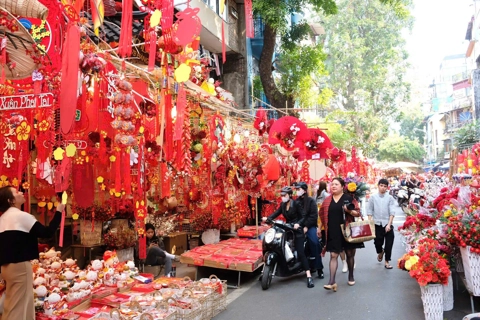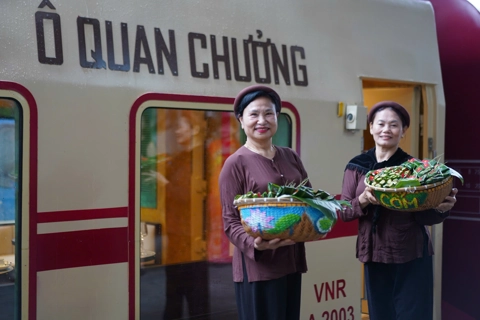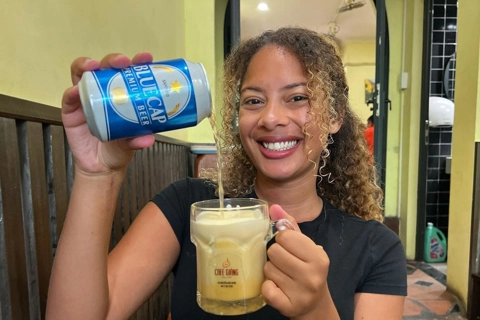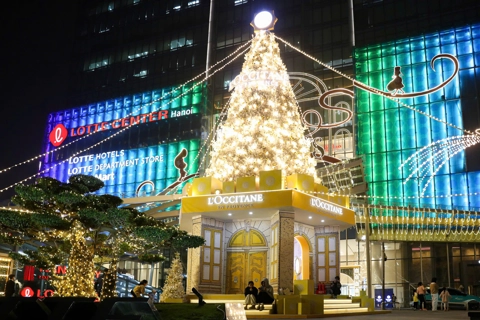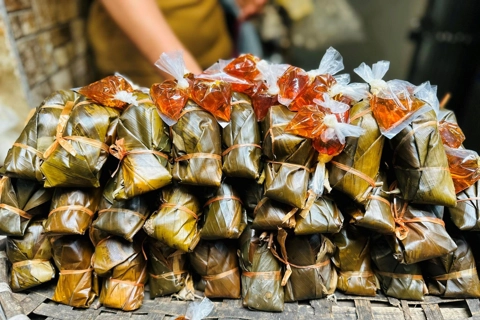Life
Unique images of Central Highlands showcased
Jul 12, 2014 / 10:54 AM
Images of ethnic people with indigenous tattoos and bare chests depicting life in the Central Highlands, are among rare pictures displayed at an exhibition that opened yesterday in Ha Noi.
Titled ‘Central Highlands of Viet Nam in the 50s of the 20th century', the exhibition showcased a collection of ethnographic documentary photos taken by French photographer Jean-Marie Duchange, from 1952 to 1955.

The Viet Nam Museum of Ethnology organised the event in the hope of sharing the photographer's values of art and science with the public, showing gratitude toward the photographer, and to celebrate the 40th anniversary of Viet Nam – France diplomatic relations, according to director Vo Quang Trong.
"This is an art exhibition with ethnographic images, and is valuable evidence of life in the 1950s," Trong said.
"These amazing works are displayed in an open space, creating a comfortable feeling for the viewers, making a close connection with rural life at that time," he added.
"The photo collection gives the viewers a vivid mosaic painting of old women and men, and young boys and girls, dressed in unique clothes in the Central Highlands in the middle of the 20th century, that are now rare."
"Admirable costumes, hairstyles and jewels for women and men that are out of fashion today, will be seen in those photos."
In addition, the system of travelling by elephants, daily activities like cultivating, rice pounding, cloth weaving and cotton ginning, ritual activities including funerals, buffalo sacrifice, harvest season praying and especially the architecture that formed the features of the Central Highlands (long houses, communal houses and barns apart from mountain huts and graves) have also been carefully captured in the photos.
Nguyen Duc Minh, 10, visited the exhibition with his grandparents and was excited when he saw elephants carrying people and goods across the river.
"After seeing so many pictures of elephants here, I understand how closely connected they were to people's life," he said. "I was told that elephants never cross any bridge because they are afraid. I think they knew how heavy they were."
The exhibition, displaying 34 large square-shaped images (reproductions of the original negative films from the collection of 200), were printed in France on transparent material that allows viewers to see the images from both sides.
A collage of photos in a mosaic painting and a video clip, have also been made to provide the public with a panoramic view.
A tool used by the photographer, the Rolleiflex camera, will also be on display at the exhibition. A "dark room" (camera obscura) – the forerunner to the photographic camera – has been reconstructed in the centre of the gallery. This will give the public an exciting view of the photo industry.
Thanks to this giant "tool", visitors who are interested in photography will be able to understand the inverted images of the objects on the wall of the dark chamber.
In the preface of a photo album Duchange intended to publish when he was 88, he has written, "I want to tell you that I am neither an anthropologist nor a photographer, but I decided to get involved. I took pictures just for fun."
However, his death made this project only feasible on paper.
Recently, his daughter Evelyne Duchange, and his grand-daughter Nadege Duchange have donated one set of the film's negatives to the Quai Branly Museum (France) and another set to the Viet Nam Museum of Ethnology.
Duchange used Rolleiflex and Samflex advanced cameras to take pictures. Since the photographer and his family have been taking good care of the collection, it is still in perfect condition.
Duchange was born in 1919. He worked as a sanitary agent in the Central Highlands of Viet Nam from 1952 to 1955, where he took these beautiful pictures during his work.
When the exhibition closes on January 11 next year, the collection will be introduced to the Central Highlands.
Evelyne Duchange said she was happy that the collection will be brought to its original place where her father lived and worked.
"This is an art exhibition with ethnographic images, and is valuable evidence of life in the 1950s," Trong said.
"These amazing works are displayed in an open space, creating a comfortable feeling for the viewers, making a close connection with rural life at that time," he added.
"The photo collection gives the viewers a vivid mosaic painting of old women and men, and young boys and girls, dressed in unique clothes in the Central Highlands in the middle of the 20th century, that are now rare."
"Admirable costumes, hairstyles and jewels for women and men that are out of fashion today, will be seen in those photos."
In addition, the system of travelling by elephants, daily activities like cultivating, rice pounding, cloth weaving and cotton ginning, ritual activities including funerals, buffalo sacrifice, harvest season praying and especially the architecture that formed the features of the Central Highlands (long houses, communal houses and barns apart from mountain huts and graves) have also been carefully captured in the photos.
Nguyen Duc Minh, 10, visited the exhibition with his grandparents and was excited when he saw elephants carrying people and goods across the river.
"After seeing so many pictures of elephants here, I understand how closely connected they were to people's life," he said. "I was told that elephants never cross any bridge because they are afraid. I think they knew how heavy they were."
The exhibition, displaying 34 large square-shaped images (reproductions of the original negative films from the collection of 200), were printed in France on transparent material that allows viewers to see the images from both sides.
A collage of photos in a mosaic painting and a video clip, have also been made to provide the public with a panoramic view.
A tool used by the photographer, the Rolleiflex camera, will also be on display at the exhibition. A "dark room" (camera obscura) – the forerunner to the photographic camera – has been reconstructed in the centre of the gallery. This will give the public an exciting view of the photo industry.
Thanks to this giant "tool", visitors who are interested in photography will be able to understand the inverted images of the objects on the wall of the dark chamber.
In the preface of a photo album Duchange intended to publish when he was 88, he has written, "I want to tell you that I am neither an anthropologist nor a photographer, but I decided to get involved. I took pictures just for fun."
However, his death made this project only feasible on paper.
Recently, his daughter Evelyne Duchange, and his grand-daughter Nadege Duchange have donated one set of the film's negatives to the Quai Branly Museum (France) and another set to the Viet Nam Museum of Ethnology.
Duchange used Rolleiflex and Samflex advanced cameras to take pictures. Since the photographer and his family have been taking good care of the collection, it is still in perfect condition.
Duchange was born in 1919. He worked as a sanitary agent in the Central Highlands of Viet Nam from 1952 to 1955, where he took these beautiful pictures during his work.
When the exhibition closes on January 11 next year, the collection will be introduced to the Central Highlands.
Evelyne Duchange said she was happy that the collection will be brought to its original place where her father lived and worked.

